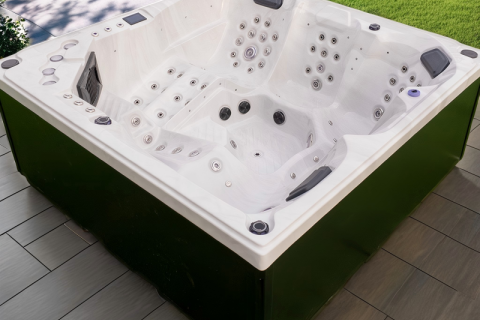
- Home
- >
News
High-Frequency Outdoor Use (2-4 People) · Recommended Thickness: 6mm-8mm · Reason: Outdoor temperatures fluctuate significantly, water depths are higher, and the structure withstands greater pressure. Thick acrylic effectively prevents stress cracks and surface deformation caused by thermal expansion and contraction.
While values vary between manufacturers, based on industry standards, it is generally accepted that: · The load-bearing limit for a standard 2- to 4-person acrylic spa tub is 1000-1200 kg · The load-bearing limit for a medium- to large-sized 6-person tub is 1600-2000 kg · Custom-made luxury acrylic spa tubs can withstand loads exceeding 2500 kg.
Improper installation is one of the primary factors that lead to repeated cracking in acrylic spa tubs: · The bottom of the tub is not fully in contact with the ground, resulting in uneven stress concentration in the suspended area; · Failure to use appropriate foam fillers or support frames; · Failure to account for minor unevenness in the wall or floor tiles during installation, leading to abnormal pressure points in the tub.
Acrylic spa bathtubs: A thick layer of acrylic (usually 2-5mm thick) is visible, with a fiberglass reinforcement layer underneath. Fiberglass bathtubs: The overall surface is thinner, with no visible acrylic panels. The interior is often a one-piece glass fiber composite material.
Thoroughly clean the acrylic spa bathtub with warm water and a neutral detergent: · Clean the surface thoroughly with a soft cloth, especially around the nozzles and crevices; · If scale is present, soak the area with a 1:1 mixture of white vinegar and water before wiping; · Avoid using harsh, corrosive cleaners containing chlorine, ammonia, or ethanol.
Maintaining cleanliness is fundamental to maintaining an acrylic spa tub and the first step to preventing material aging and system failure. 1. Frequency of Use and Cleaning Recommendations Daily Use: Clean after each use 2-3 times a week: Clean twice a week Occasional Use: Clean after each use
Acrylic spa tub crack repair process Step 1: Clean the cracked area Step 2: Sand the surface Step 3: Apply repair agent Step 4: Natural or heat cure Step 5: Fine sanding and polishing Step 6: Apply protective oil
Yes. Under the conditions of controlling concentration, time and temperature, hydrogen peroxide below 3% is one of the safe and usable disinfectants for acrylic spa tubs. Prohibited behaviors: ·Use of high concentration hydrogen peroxide above 30%; ·High temperature (>40°C) or long time (>1 hour) standing; ·Mixed with chlorine cleaners; ·Injected directly into the acrylic hot tub circulation system without dilution.








